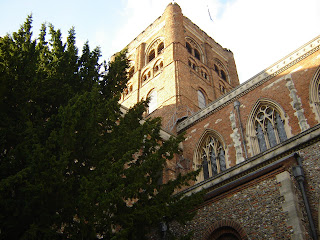Tuesday afternoon, 21 September St. Albans
After a long weekend in Scotland traveling on bus and train you'd think that we'd take it easy once we were back ensconced in our small cottage in London. Oh no, not us. Do we need a recovery period? Absolutely not. Not when we can join the SU theater students for a short train jaunt up to St. Albans. We caught a ThamesLink train at St.. Pancras for the half hour ride to this cathedral city about 22 miles north and a bit west of London. A charming little middle class sort of town oozing with more history than the whole state of Texas. Really.
This house and the one above don't represent the typical St. Alban home, but they are lovely. The is the visitor's center for the ruins of the Roman theatre we came to see.
Ruins of the theatre of the ancient Roman city of Verulamium, the main reason we're in St. Albans. This view is towards the stage. The theatre held 7000 people.
This picture is from behind the stage.
We're standing in front of the foundations of a Roman villa. Only yards away from the theatre, this must have been a well-to-do family.
Site of what archeologists believe were a row of shops.
Verulamium (on the River Ver) was the third largest Roman settlement in Britain. Queen Boudicca and her followers, not willing to bend under Roman rule, sacked the town, as she did London and Colchester.
The modern Verulamium Museum exhibits the local Roman treasures unearthed over the last few decades. The floor mosaics are especially exquisite, among best preserved, if I remember correctly, of all the mosaics in Britain.
A small statue of Mercury. There is also a lovely small statue of Venus.
Ancient tweezers.
The students crossing a bridge in Verulamium Park on their way to the cathedral.
A very old pub between the park and the cathedral.

St. Albans Cathedral. St. Albans hid a Christian, converted, and suffered execution for his troubles. The first Christian martyr in Britain, the town and cathedral were named in his honor. The story is that the cathedral stands at the site of his execution.
The cathedral's history extends back to 790 when it was founded as a Benedictine abbey and monastery. The oldest part is one of the few remaining examples of Saxon architecture. Later additions to the abbey transformed it into a cathedral, and each addition reflected a different style. This tower is in the later Norman style.
A list of all the abbots and bishops.
The nave.
The vaults above the nave.
A public house near the cathedral.
A medieval tower.
The significance of the tower is written on these plaques.
A plaque on a building just a few yards from the tower.
That was our afternoon at St. Albans. We discovered a wonderful tea room overlooking a lovely garden near the cathedral. We hope to return to sip some tea and eat some scones and explore the town some more.
After dinner at a French restaurant we hopped back on the train and went home.






















Very informative and impressive post you have written, this is quite interesting and i have went through it completely, an upgraded information is shared, keep sharing such valuable information. St Albans Recovery
ReplyDeleteExcellent post and wonderful blog, this sort of interesting posts I really like, keep it up... Tim hornibrook
ReplyDelete